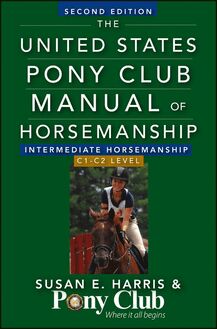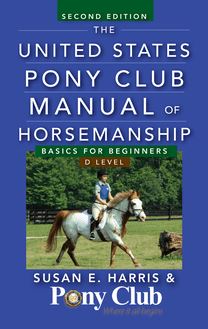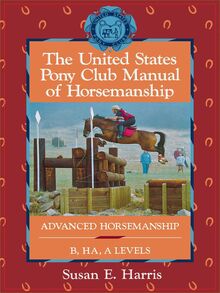The United States Pony Club Manual Of Horsemanship Intermediate Horsemanship (C Level) , livre ebook
242
pages
English
Ebooks
2012
Vous pourrez modifier la taille du texte de cet ouvrage
Obtenez un accès à la bibliothèque pour le consulter en ligne En savoir plus
Découvre YouScribe en t'inscrivant gratuitement
Découvre YouScribe en t'inscrivant gratuitement
242
pages
English
Ebooks
2012
Vous pourrez modifier la taille du texte de cet ouvrage
Obtenez un accès à la bibliothèque pour le consulter en ligne En savoir plus
Publié par
Date de parution
03 décembre 2012
Nombre de lectures
0
EAN13
9781118238608
Langue
English
Poids de l'ouvrage
2 Mo
This C Level manual builds on material covered in The United States Pony Club Manual of Horsemanship: Basics for Beginners/D Level. Whether you're a Pony Clubber who has passed the D Level tests or simply a rider who has mastered the same basics, this manual enables you to increase your skills and teach you what you need to know in order to rise independently and correctly with good position, balance, and use of the aids on the flat, over fences, and in the open.
At the intermediate level you're expected to take more responsibility for the care and management of your pony, and you'll learn how to do this as well. In addition, you'll learn the skills needed for conditioning and preparing your pony and yourself for competitions and special events.
- New and revised coverage of land conservation and horse health and safety
- Better organization to ease reference
- A full review and update of critical developments in riding, instruction, and competition
- In-depth revision of nutrition and veterinary topics, the two areas in which there has been the most significant research and development over the past two decades
From the C Level, you may go on to higher Pony Club ratings such as B, H, A, or A Ratings, or specialize in such disciplines as dressage, show jumping, eventing, and showing. Or you may just want to have the pleasure of caring your horse or pony and participating in your favorite riding activities. Either way, The United States Pony Club Manual of Horsemanship: Intermediate Horsemanship/C Level will give you an excellent basis in horsemanship for the lifelong enjoyment of horses and horse sports.
A Note from the United States Pony Clubs, Inc. vi
A Note to the Reader viii
1 Riding on the Flat 1
2 Riding Over Fences 50
3 Riding and Jumping in the Open 91
4 Horse Care and Management 118
5 Feeding, Watering, and Nutrition 167
6 Health Care and Veterinary Knowledge 179
7 Conditioning 222
8 Shoeing 247
9 Travel Safety and Bandaging 260
10 Ground Training: Handling, Leading, and Longeing 281
11 Teaching and Assisting with Pony Club Activities 306
12 Conformation, Movement, and Soundness 318
Index 345
Publié par
Date de parution
03 décembre 2012
Nombre de lectures
0
EAN13
9781118238608
Langue
English
Poids de l'ouvrage
2 Mo
Also by Susan E. Harris
Horsemanship in Pictures
Grooming to Win, Third Edition
Horse Gaits, Balance and Movement
The United States Pony Club Manual of Horsemanship: Basics for Beginners/D Level
The United States Pony Club Manual of Horsemanship:Advanced Horsemanship/B & A Levels
This book is not intended as a substitute for professional advice and guidance in the field of horseback riding. A young person should take part in the activities discussed in this book only under the supervision of a knowledgeable adult.
Copyright © 2013 by Susan E. Harris and the United States Pony Clubs, Inc. All rights reserved.
Howell Book House
Published by John Wiley & Sons, Inc., Hoboken, New Jersey
No part of this publication may be reproduced, stored in a retrieval system or transmitted in any form or by any means, electronic, mechanical, photocopying, recording, scanning or otherwise, except as permitted under Sections 107 or 108 of the 1976 United States Copyright Act, without either the prior written permission of the Publisher, or authorization through payment of the appropriate per-copy fee to the Copyright Clearance Center, 222 Rosewood Drive, Danvers, MA 01923, (978) 750-8400, fax (978) 646-8600, or on the web at www.copyright.com . Requests to the Publisher for permission should be addressed to the Permissions Department, John Wiley & Sons, Inc., 111 River Street, Hoboken, NJ 07030, (201) 748-6011, fax (201) 748-6008, or online at http://www.wiley.com/go/permissions .
Wiley, the Wiley logo, Howell Book House, and related trademarks are trademarks or registered trademarks of John Wiley & Sons, Inc. and/or its affiliates. All other trademarks are the property of their respective owners. John Wiley & Sons, Inc. is not associated with any product or vendor mentioned in this book.
The publisher and the author make no representations or warranties with respect to the accuracy or completeness of the contents of this work and specifically disclaim all warranties, including without limitation warranties of fitness for a particular purpose. No warranty may be created or extended by sales or promotional materials. The advice and strategies contained herein may not be suitable for every situation. This work is sold with the understanding that the publisher is not engaged in rendering legal, accounting, or other professional services. If professional assistance is required, the services of a competent professional person should be sought. Neither the publisher nor the author shall be liable for damages arising here from. The fact that an organization or Website is referred to in this work as a citation and/or a potential source of further information does not mean that the author or the publisher endorses the information the organization or Website may provide or recommendations it may make. Further, readers should be aware that Internet Websites listed in this work may have changed or disappeared between when this work was written and when it is read.
For general information on our other products and services or to obtain technical support please contact our Customer Care Department within the U.S. at (877) 762-2974, outside the U.S. at (317) 572-3993 or fax (317) 572-4002.
John Wiley & Sons, Inc., also publishes its books in a variety of electronic formats and by print-on-demand. Not all content that is available in standard print versions of this book may appear or be packaged in all book formats. If you have purchased a version of this book that did not include media that is referenced by or accompanies a standard print version, you may request this media by visiting http://booksupport.wiley.com . For more information about Wiley products, visit us at www.wiley.com .
Library of Congress Control Number: 2012948919
ISBN: 978-1-118-13349-1 (paper)
ISBN: 978-1-118-22515-8 (ebk)
ISBN: 978-1-118-26326-6 (ebk)
ISBN: 978-1-118-23860-8 (ebk)
Printed in the United States of America
10 9 8 7 6 5 4 3 2 1
Second Edition
Photographs by Shelley Mann, USPC
Illustrations by Susan E. Harris
Book design by Lissa Auciello-Brogan
Cover design by Wendy Mount
Book production by John Wiley & Sons, Inc. Composition Services
Updates to this book are available on the Downloads tab at this site: http://www.wiley.com/WileyCDA/WileyTitle/productCd-1118133498.html . If a Downloads tab does not appear at this link, there are no updates at this time.
Contents
A Note from the United States Pony Clubs, Inc.
A Note to the Reader
1 Riding on the Flat
2 Riding Over Fences
3 Riding and Jumping in the Open
4 Horse Care and Management
5 Feeding, Watering, and Nutrition
6 Health Care and Veterinary Knowledge
7 Conditioning
8 Shoeing
9 Travel Safety and Bandaging
10 Ground Training: Handling, Leading, and Longeing
11 Teaching and Assisting with Pony Club Activities
12 Conformation, Movement, and Soundness
A Note from the United States Pony Clubs, Inc.
Pony Club started in Great Britain in 1928 with 700 original members. By 1992 there were more than 125,000 members in 27 countries, making it the largest junior equestrian group in the world. Each club is run by a volunteer District Commissioner and other elected officers and each riding center is run by a Central Administrator. At this writing, the United States Pony Clubs have over 10,000 members in more than 600 clubs or riding centers.
We suspect that the first requests from United States Pony Club members for a manual of their own were received in 1954, when the first U.S. clubs were founded. By 1979, when the Instruction Council rewrote the USPC Standards, it was determined that there was a need for one source of information that members could consult as they progress through the certification levels. The first United States Pony Club manual that matched our standards and used terms specific to North America was created in 1994. The USPC Standards were revised again in 2009, creating a need for this newly revised C Level Manual.
Author and illustrator Susan E. Harris, an experienced and successful riding instructor and clinician, has received guidance from an advisory panel that represents years of teaching, coaching, and examining riding and horse management skills within the USPC. We would like to express our thanks to the Standards and Curriculum Chair, Kim Lowman Vollmer, U.S. Pony Club Graduate A, and her C Level Manual Committee for their hours of dedication in revising and updating this book. We also thank Dr. Stacy Anderson, DVM, MVSc, U.S. Pony Club Graduate A, for her help with veterinary subjects.
USPC’s Mission
The United States Pony Clubs, Inc., develops character, leadership, confidence, and a sense of community in youth through a program that teaches the care of horses and ponies, riding, and mounted sports.
USPC’s Core Values
• Horsemanship with respect to healthcare, nutrition, stable management, handling, and riding a mount safely, correctly, and with confidence.
• Organized teamwork, including cooperation, communication, responsibility, leadership, mentoring, teaching, and fostering a supportive yet competitive environment.
• Respect for the horse and self through horsemanship, for land through land conservation, and for others through service and teamwork.
• Service by providing an opportunity for members, parents, and others to support the Pony Club program locally, regionally, and nationally through volunteerism.
• Education at an individual pace to achieve personal goals and expand knowledge through teaching others.
Sportsmanship, Stewardship, Leadership through Horsemanship
A Note to the Reader
Pony Club supports the ideal of a thoroughly happy, comfortable horseperson, riding across a natural country, with complete confidence and perfect balance on a horse or pony equally happy and confident and free from pain or bewilderment.
This book is for riders who have learned the material covered in the United States Pony Club Manual of Horsemanship: Basics for Beginners/D Level , and for Pony Club members who have achieved the USPC D Level certifications. Even if you are not a Pony Club member, you need to know the D Level work that forms the basis for this Intermediate Manual.
This book is meant to be used along with a regular course of instruction in riding, horse knowledge, and horse management, taught according to USPC Standards of Proficiency. The Pony Club philosophy is to teach you the correct and safest method to accomplish a task. There is no one “Pony Club” way, but there is a safe and careful way to get the job done so that you and your horse or pony are as happy and as comfortable as possible in this sport.
It’s very important to read the USPC D Level Manual before going on to this one. Everything in the Intermediate Manual is based on what is taught at the D Level, and some subjects covered there are not included here. As a Pony Club member, you are responsible for knowing D Level material that is not repeated in this book, and you can’t pass Pony Club C, B, or A Level certification unless you do. Even if you are not a Pony Club member, you need to know the D Level foundation work first in order to learn from this book. Pony Club members will also need to do outside reading (see the USPC Recommended Reading List for your level, and also follow your instructor’s and District Commissioner or Central Administrator’s recommendations).
No book can take the place of a good instructor, and some activities can be quite unsafe for you and for your horse if you try to do them on your own without instruction. Your instructor will help you progress at your own rate.
The USPC Standards of Proficiency for the C Level are used to determine when a Pony Club member is ready to move on to the next level.


